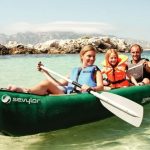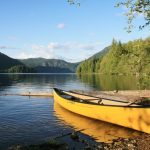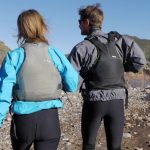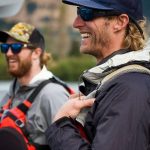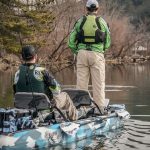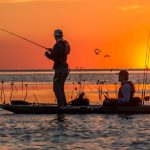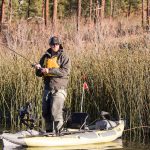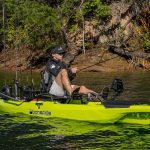Inflatable canoes are easy to transport and store. Here is our list of the best inflatable models to help you make the right choice.
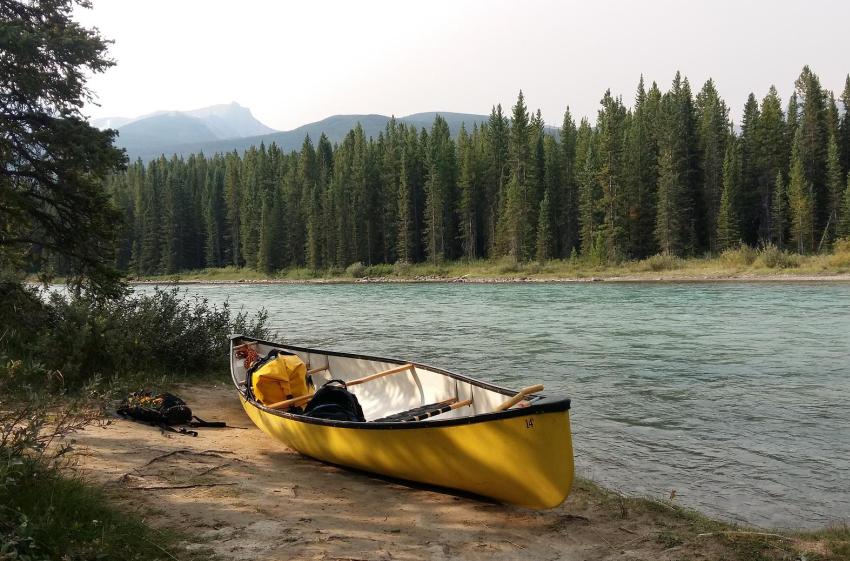
Canoes have been used by fishermen all around the world for thousands of years. With modern design, the lines are often blurred between canoes and kayaks and their double-bladed counterparts have taken the limelight in the fishing world.
There is still a place in angling for the humble canoe though. Canoes offer a serene and relaxing experience out on the water, with the opportunity to pair up and cover great distances to find your perfect fishing spot. The onboard storage options and hull depth of a canoe mean you can easily turn your day of fishing into an overnight adventure, without compromising storage for your angling equipment.
Our guide to fishing canoes gives you the best options on the market at present so that you can pick the right boat for your next trip.
As an affiliate of Amazon and other retailers, we may earn a small commission when you buy via our links, at no additional cost to you. Thank you!
Best Fishing Canoes at a Glance
- Best Solo Canoe: Old Town Sportsman Discovery 119
- Best Tandem: Old Town Saranac 160
- Best For the Family: Lifetime Kodiak
- Best Inflatable: Sea Eagle TC16
- Best Budget: Sun Dolphin Mackinaw SS
- Best Square Stern: Esquif Mallard XL
- Best Lightweight: Wenonah Fishing Canoe
Comparison table: Best Fishing Canoes
| Model | Specs | Where To Buy |
 Old Town Sportsman Discovery 119 | Size: 11 ft. 9 in. x 32 in. Weight: 56 lbs. Capacity: 354 lb | Amazon |
 Old Town Saranac 160 | Size: 16 ft. x 37 in. Weight: 89 lbs Capacity: 850 lbs | REI |
 Lifetime Kodiak | Size: 13 ft. x 39 in. Weight: 96 lbs Capacity: 600 lbs | Amazon |
 Sea Eagle TC16 | Size: 16 ft. x 38 in. Weight: 64 lbs Capacity: 915 lbs | Amazon |
 Sun Dolphin Mackinaw SS | Size: 15 ft. 6 in. x 40 in. Weight: 95 lbs Capacity: 800 lbs | Amazon |
 Esquif Mallard XL | Size: 12 ft. 4 in. x 39.75 in. Weight: 59 lbs Capacity: Not stated | Esquif |
Wenonah Fishing Canoe | Size: 14 ft. x 39 in. Weight: 36 lbs Capacity: Not stated | Boundary Waters Catalog |
Best Solo: Old Town Sportsman Discovery 119
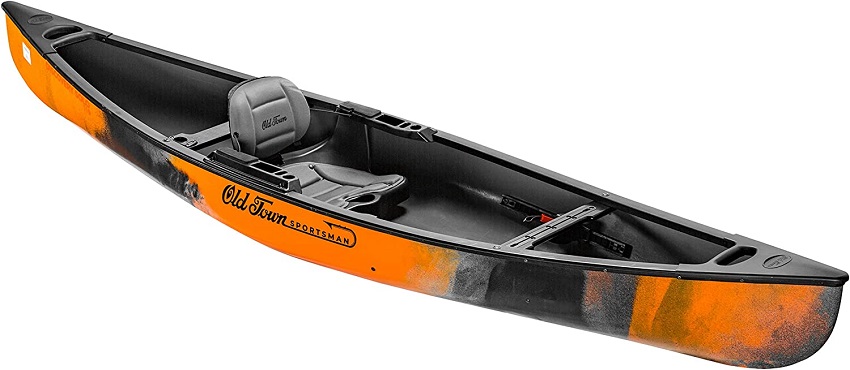
Length: 11 ft. 9 in. (3.5 m)
Width: 32 in. (81 cm)
Weight: 56 lbs. (25.4 kg)
Capacity: 354 lbs. (161 kg)
Material: Triple Layer Polyethylene
The Old town Sportsman Discovery 119 is a solo canoe designed specifically for anglers and sportsmen. A triple-layer polyethylene construction makes this canoe durable enough to withstand heavy use in rough areas. Despite this heavy-duty construction, the Sportsman Discover 119 weighs just 56 lbs., easy enough for a solo canoeist to load onto a trailer or trolley.
The padded seating is designed for all-day comfort, with a fully contoured and padded seat pad and adjustable backrest system. This seat comes with an integrated cup holder and four flush-mounted rod holders – two forward and two rear-facing. Unusually for a canoe, the Sportsman Discovery 119 has an adjustable footrest system.
Old Town has balanced the length and width to make the sportsman nimble and easy to paddle in all conditions, without limiting straight-line speed. The upper capacity of 354 lbs. is plenty for an adult and their fishing equipment to take to the water. The forward thwart also has an on/off accessory mount rail.
Pros:
- Comfortable and supportive seating
- Designed specifically for solo canoeists
- Good level of fishing features
Cons:
- Narrow for standing to cast
- The full seat system makes it harder to move around the canoe
Best Tandem: Old Town Saranac 160
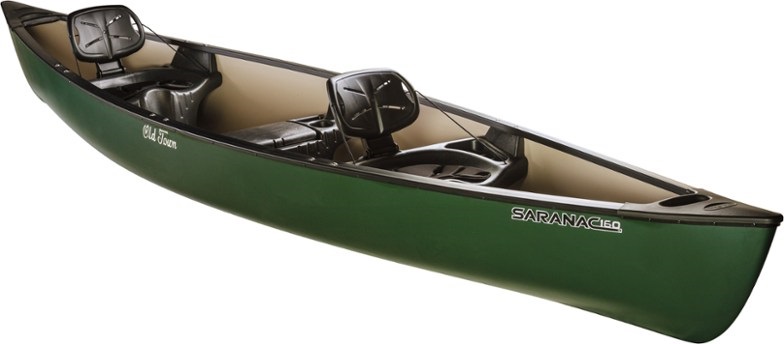
Length: 16 ft. (4.87 m)
Width: 37 in. (94 cm)
Weight: 89 lbs. (40 kg)
Capacity: 850 lbs. (385 kg)
Material: Thermoformed Polyethylene
The Old Town Saranac 160 is an all-around recreational canoe that can be used for angling. With an enormous 850 lb. capacity and a 2+1 seating setup, this is the boat of choice for families who often canoe together. The heavy-duty thermoformed polyethylene construction means that this canoe will still be going even when the kids have grown up and got canoes of their own.
The bow and stern seats of the Saranac 160 are molded for all-day comfort, while the middle seat doubles as storage. Under the +1 seat, there is a storage box that can be used for fishing equipment, snacks, or spare layers. There is also dry storage for essential items. A rod holder on the middle seat and the bow seat let you go hands-free as you paddle between spots.
The Saranac 160 has a wide and flat hull, great for youngsters to explore the boat as well as anglers to have a casting platform. The defined keel line and limited rocker profile mean that this canoe has a reasonable top speed over the water and will track efficiently.
Pros:
- High capacity
- 2+1 seating makes this a great family canoe
- Good features for a recreational focused canoe
Cons:
- Heavy
Best For the Family: Lifetime Kodiak
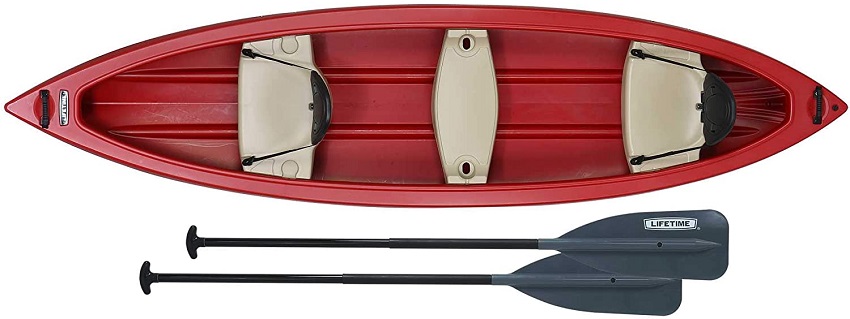
Length: 13 ft. (396 cm)
Width: 39 in. (99 cm)
Weight: 96 lbs. (43.5 kg)
Capacity: 600 lbs. (272 kg)
Material: Polyethylene
The Lifetime Kodiak has a simplistic, approachable design that makes it our pick for a family-friendly fishing canoe. This is a canoe for those who regularly take the family out on the water, but also want a canoe to load up with fishing equipment and head out in search of a catch. The three molded seats are fitted as standard, with removable backrests for the bow and stern seats.
Made from high-density polyethylene, the Lifetime Kodiak is designed to stand up against the hardships that family life can throw at it, as well as years of UV exposure. This hull is also designed to be used with a motor, and a mounting bracket can be bought as an optional extra.
As this is a family-oriented canoe, it’s not heavy on the fishing features, but where it lacks in features it makes up for it in stability and easy paddling. The shaped bow and skeg combine for good tracking and easy paddling, while a wide hull gives you enough stability to stand and cast. There are rod holders in the central seat, as well as a water bottle, or cup holders for all three seats.
Pros:
- Easy to paddle and stable
- Family-friendly
- Highly durable
Cons:
- Heavy
- Not a lot of fishing-specific features
- Three fitted seats don’t give you a load of space to move around
Best Inflatable: Sea Eagle TC16
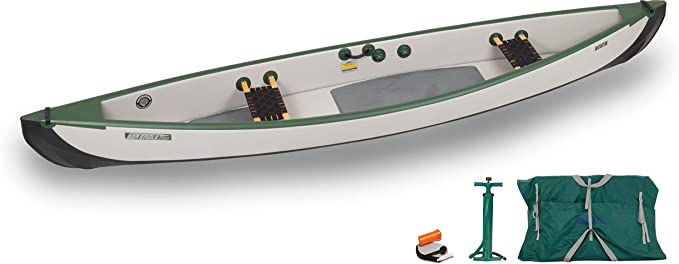
Length: 16 ft. (4.88 m)
Width: 38 in. (97 cm)
Weight: 64 lbs. (29 kg)
Capacity: 915 lbs. (415 kg)
Material: 1000 Decitex Reinforced
If you’re short on space either at home or in your truck, an inflatable canoe could be the answer. The Sea Eagle TC16 is one of the best inflatable canoes on the market and uses drop-stitch seams throughout for a high-pressure design. Unlike some traditional inflatables, this gives the TC16 the feel and performance of a more rigid canoe.
It would be understandable if you were a little nervous about using an inflatable canoe for a sport involving so many hooks and tools. The reinforced material of the TC16 is designed to stand up against rocks and shorelines and is more than capable of holding up against angling equipment.
The open deck design of the TC16 gives you loads of space to stow gear and move around. The grippy deck pad also makes this a great platform to stand and cast from. Because the seats are removable, you can customize your canoe each time you go out, choosing between one and three seats. The high capacity of the TC16 means you won’t have to scrimp on gear either, although there are no fishing-specific features for storage.
Pros:
- Easy to store and transport
- High-pressure design for rigid performance
- Stable and easy to paddle
Cons:
- Affected by the wind
- Requires time to pump it up before you can launch
- No fishing-specific features
Best Budget: Sun Dolphin Mackinaw SS

Length: 15 ft. 6 in. (4.72 m)
Width: 40 in. (101 cm)
Weight: 95 lbs. (43 kg)
Capacity: 800 lbs. (363 kg)
Material: High-density polyethylene
The budget-friendly Sun Dolphin Mackinaw SS is an all-around recreational canoe that is equally at home on family days out as it is for fishing trips. The defined keel line gives you reasonable speed over the water and easy tracking. A squared-off stern is motor-ready, so you can mount your electric trolling motor and cruise.
There is onboard seating in the Mackinaw SS for three paddlers. The central seat also doubles as a cooler, perfect for storing drinks on a hot day out on the lake. Cup holders and rod holders are molded into the design for comfort, while paddle holders on the central seat let you fish without losing your paddle.
Despite the width, the Mackinaw SS is not suited to stand-up casting. The hull has a slight v-shape to it that tapers to the keel line, which means that you will spend the whole time bracing slightly as you stand. Even so, the seats offer a high position to cast from and the Mackinaw has plenty of onboard space to make use of the high capacity.
Pros:
- Budget-friendly price
- High capacity
- Defined keel
- Motor-ready
Cons:
- Not suited to standing to cast
- Molded seats are narrow
- Heavy
Best Square Stern: Esquif Mallard XL
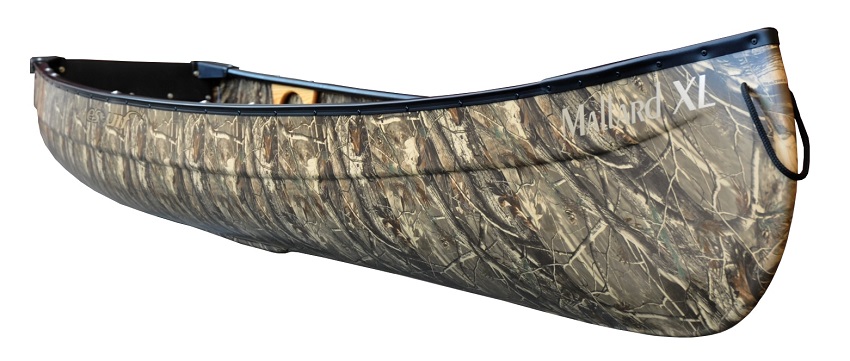
Length: 12 ft. 4 in. (3.78 m)
Width: 39.75 in. (101 cm)
Weight: 59 lbs. (26.7 kg)
Capacity: Not stated
Material: T-Formex thermoformed plastic
The Esquif Mallard XL is a fully motor-ready canoe that has enough space on board to take up to four paddlers. The T-Formex construction means it’s light enough to load up on your truck, or carry between two people. The T-Formex also makes the Mallard XL stand up well against impact and long-term UV damage.
RELATED: Best Square Stern Canoes
When it comes to specific fishing features, the Mallard is lacking slightly. However, there is plenty of space on board for all of your fishing gear, as well as room to move around and comfortably stand to fish. The clearly defined keel line and wide hull make this a stable canoe that tracks reasonably against the wind.
The Mallard XL has two wide seating platforms that could reasonably carry three and perhaps four passengers. Esquif hasn’t stated the capacity of the Mallard XL, but the standard Mallard model has a capacity of 600 lbs. (272 kg). Remember that your capacity will include the motor, which most paddlers will choose to mount onto the Mallard XL.
Pros:
- Open and stable design for easy casting
- Motor-mount ready
- Strong and durable build
Cons:
- The width makes this tiring to paddle
- Limited features
Best Lightweight: Wenonah Fisherman 14’ Ultralite Aramid
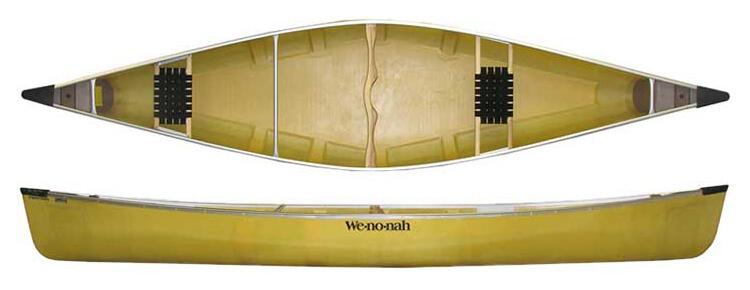
Length: 14 ft. (4.27 m)
Width: 39 in. (99 cm)
Weight: 36 lbs. (16 kg)
Capacity: Not stated
Material: Aramid composite
Wenonah is renowned for making some of the most advanced canoes on the market. The Fisherman 14’ Ultralight Aramid is not just one of the lightest fishing canoes on the market, but at just 36 lbs. is one of the lightest canoes overall. This canoe is light enough to easily load onto your car rooftop or carry to the water.
It’s strong, too. Aramid is used in aircraft construction and bulletproof vest manufacturing, so it can stand up against shorelines and rocks as you paddle. Aramid doesn’t bounce like plastic boats and won’t retain its shape in the same way either, so there is care needed in swifter currents.
The Fisherman 14’ is designed for stability, not speed. The short stature and broad beam make it sluggish through the water and inappropriate for heavy loads or big waves. For two adults heading out fishing though, this is an easy canoe to paddle and you’ll be comfortable hauling your load onboard, or laying back and watching the stars over the lake.
Pros:
- Ultralight design for easy portability
- Wide and stable
- Easy to control
Cons:
- Short length limits speed
- High price tag
Best Fishing Canoes Buying Guide
Benefits of a Canoe for Fishing
In the fishing world, kayaks have overtaken canoes as the preferred craft. So why would you choose a canoe over a kayak? For a full rundown of the difference between the two crafts, check out our article on canoes vs kayaks.
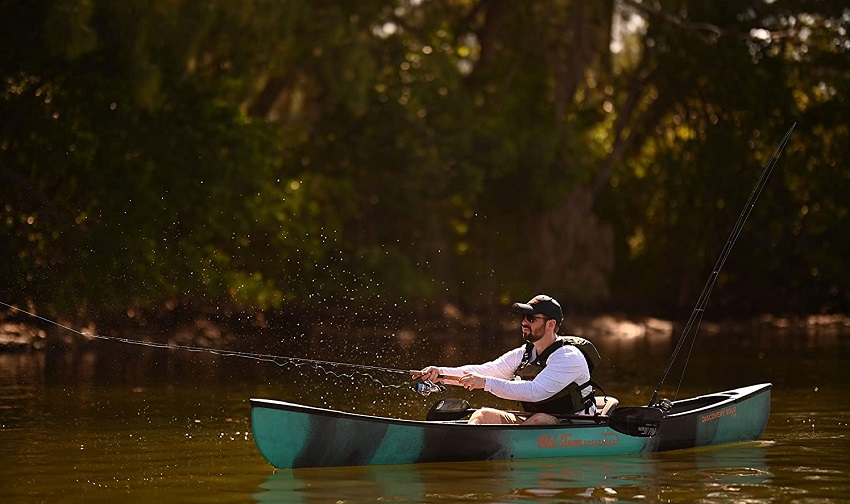
Canoes have the luxury of space. When you look at storage options in a kayak, they are usually rigidly defined areas of the boat that fit particular elements of your fishing setup. This is great if that setup works for you and you like your cooler at the back of the boat, your tackle boxes under your seat, and your get mounted wherever they fit the gear tracks.
A canoe will give you choice, though. You can load up your gear however and wherever you find works for you. You also have the option to load up with expedition equipment and turn your trip into an overnight.
RELATED: Canoe Camping: The Ultimate Guide
The seating in a canoe is usually higher and more accessible than it is in a kayak. This not only makes it easier to get in and out but gives you greater command of the water. Often fishing kayaks do come with high-rise seats, but because of the need to reach the water with a double-bladed paddle, you’re usually much closer to the water.
Length
There are a lot of arguments around canoe and kayak camp over which are quicker and more efficient, so we’re going to settle the score once and for all. Your speed is directly affected by how long your canoe or kayak is and how much is in contact with the water. This means a long canoe with a narrower beam will outstrip a kayak with a shorter stature.
Unless you’re a skilled solo canoeist, longer canoes are harder to control, especially in the wind though. Picking the length of your canoe will depend on how many paddlers you want onboard, as well as equipment. Don’t forget storage, too. If you buy a 17-foot-long canoe, you need space to store it properly.
Depth
Canoes are much deeper than kayaks. This gives you space to store equipment out of the wind and where the waves are unlikely to crash across it. This is also great if you take your dog out paddling with you as they can hunker down in your canoe and get comfortable.
The amount of your canoe sticking out above the water line is called the freeboard. If you load your canoe to the gunwales and are sitting low in the water, with minimal freeboard showing, you will be hugely unstable. Waves will also be able to crash over the boat and potentially tip you in.
On the opposite end, if you have a lightweight canoe with a lot of freeboard – a high-sided boat – you might find that it acts like a sail in the wind. This can make your canoe hard to control. Try to keep your freeboard at around 8-inches minimum. You can achieve this by staying within 70% of the suggested capacity.
Stability
The stability of your canoe mostly comes from the width. It is also affected slightly by hull shape and depth. A wider, flatter canoe will be more stable, but this will negatively affect the speed of your canoe as it will drag through the water.
Your canoe needs to be stable if you want to fish successfully from it. This is especially important for those who like to stand to fish, but if you’re fighting a reluctant catch in from your seat, you need to be certain that you’re not about to end up swimming around next to it.
Consider your style of fishing against how far you plan to paddle and the distance you want to cover. This will allow you to decide on whether you need a wide canoe or a slightly sleeker touring model.
Hull shape
Similar to a kayak, your canoe hull will come in different shapes. A canoe with a flatter hull will have better primary stability and will be better suited to fishing, especially if you like to stand to fish.
A shallow v-shaped hull will give the canoe better secondary stability, when the canoe is slightly heeled over. The v-shape in the hull will also act as a keel line and will give the canoe better tracking. If you want to journey further and paddle against rough weather, a slight v-shape in your hull will help you stay on course.
The rocker profile of your canoe is how rounded it is from front to back. A high rocker profile will see the bow and stern almost clear of the water and this is good for cutting through chop or river waves, but can negatively impact how well your canoe tracks into the wind. A high rockered canoe will turn more easily.
A canoe with a low rocker is more likely to have waves crash over it but can be easier to paddle in calm conditions, especially for beginners. Low rocker canoes have a longer waterline and will usually be faster than canoes with a higher rocker. These canoes are harder to make tight turns in, though.
Motor Compatibility
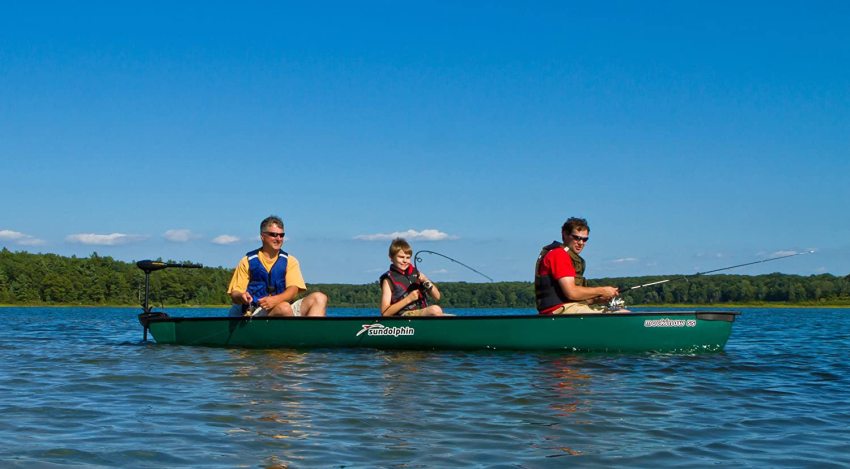
Even the lightest canoes require a reasonable amount of effort to propel. Once you load your canoe up with all of your fishing equipment it can be tiring to paddle. Let’s be honest, you want to save your energy for hauling in your catch.
Trolling motors are designed to help you cruise between fishing spots to make sure you get the right catch. Some square-backed canoes are designed specifically with motor mounting in mind and these are usually the preferred choice of regular motor users. If you don’t have a square back canoe, you can mount a side-mounted motor onto the gunwale of most canoes.
Material
Canoes are usually made from either wood, plastic, or composite materials. These different materials have different strengths and weights. If you paddle around rocks and rough shorelines, you will need a more heavy-duty canoe. Lighter canoes require less effort to propel and are also easier to load onto the roof of your car at the end of your trip.
Wooden canoes are the best looking and most in keeping with tradition. They are expensive and not as durable as modern materials, though, so we have no wooden canoes on our list of the best fishing canoes.
Plastic canoes are either rotomolded or thermoformed. Rotomolded plastics are the most durable material but make for the heaviest canoes. Thermoformed plastics use layers of thin sheets, a little like composite boats, but are highly durable and have a good level of UV protection for longevity.
Composite canoes are usually plastic shells that are reinforced with fiberglass. This keeps the weight down while giving the boat a good level of stiffness and excellent performance. However, composite canoes are not as durable as plastic canoes and the stiffness makes them more prone to cracking.
Another class of these crafts – Aluminum canoes – are the most durable both on and off the water. And they still have many fans. There are summer camps that have been using the same aluminum canoes for decades and families that have passed their canoe from generation to generation. Check our article on the best aluminum canoes available on the market.
Capacity
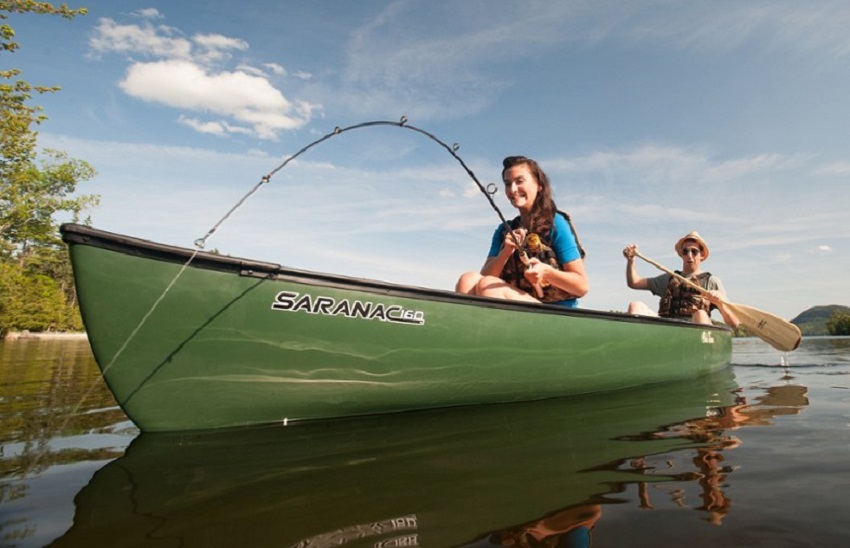
You need to know that your canoe is designed to carry as many paddlers as you want to take out with you. Make sure that there is a seat for everyone in your canoe, or space to add in a temporary seat if you occasionally take an extra passenger.
The capacity that the manufacturer attributes to a canoe is usually the upper limit of what a canoe can hold before the gunwales are underwater. Fully loaded canoes are unstable and hard to paddle and we recommend not overloading 70% of the manufacturer’s recommended capacity.
Remember that your paddling weight includes all of your chosen paddlers and their clothing and equipment. You also have to account for any fishing gear you’re taking with you. Don’t forget to save some of that capacity if you’re keeping the fish you catch.
Features
Unlike fishing kayaks, canoes tend to go a little lighter on fishing-specific features. Some canoes are fitted with fishing-specific features, while others are more open and basic in their design. You can usually mount your accessories on the thwarts inside the canoe, or along the gunwales, but this might take some adjustment and even some drilling.

